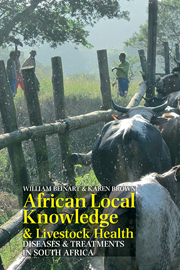Book contents
- Frontmatter
- Contents
- Acknowledgements
- Abbreviations
- Names of Common Diseases
- List of Maps, Photographs & Tables
- 1 Introduction: African Local Knowledge & Veterinary Pluralism
- 2 Ticks, Tick-borne Diseases & the Limits of Local Knowledge Introduction
- 3 ‘The Grave of the Cow is in the Stomach’: Environment & Nutrition in the Explanation & Prevention of Livestock Diseases
- 4 Transhumance, Animal Diseases & Environment
- 5 Plants & Drugs: Medicating Livestock
- 6 Medicinal Plants: Their Selection & their Properties
- 7 Animal Health & Ideas of the Supernatural
- 8 Gender, Space & the Supernatural
- 9 Conclusion
- Appendices
- Select Bibliography
- Index
6 - Medicinal Plants: Their Selection & their Properties
Published online by Cambridge University Press: 05 December 2013
- Frontmatter
- Contents
- Acknowledgements
- Abbreviations
- Names of Common Diseases
- List of Maps, Photographs & Tables
- 1 Introduction: African Local Knowledge & Veterinary Pluralism
- 2 Ticks, Tick-borne Diseases & the Limits of Local Knowledge Introduction
- 3 ‘The Grave of the Cow is in the Stomach’: Environment & Nutrition in the Explanation & Prevention of Livestock Diseases
- 4 Transhumance, Animal Diseases & Environment
- 5 Plants & Drugs: Medicating Livestock
- 6 Medicinal Plants: Their Selection & their Properties
- 7 Animal Health & Ideas of the Supernatural
- 8 Gender, Space & the Supernatural
- 9 Conclusion
- Appendices
- Select Bibliography
- Index
Summary
Our plants are powerful and they work well. Vets cannot identify and treat all diseases so we need our own medicines. Cows are like humans they get the same diseases and need the same cures. Plants that are good for humans are good for our cattle as well.
(April Nhlapo, Lusaka, QwaQwa).April Nhlapo kept his two cows and one calf in his kraal in the backyard of his house in the densely populated village of Lusaka. He explained how he loved his cows ‘they are my bank and my source of milk’. He sold milk to his neighbours and traded calves when he needed cash. Like many stockowners we interviewed in Lusaka he had a good knowledge of locally available plants and treated himself and his cattle with ‘medicines I find in the veld’.
Pre-industrial societies worked with local natural resources on a daily basis and often achieved a rich knowledge of the plant species around them. African societies used plants for a wide range of purposes, from food and building, to furniture and utensils. Plants provided countless elements of material culture and in this way they were part of a deep indigenous knowledge; people knew where they grew, which were edible, which could be cultivated, and how they could be used. Some species had specific cultural connotations or ritual functions. Plants were equally important for medicinal and veterinary uses and, as in many pre-industrial societies, the boundary between food and medicine was not always tight.
- Type
- Chapter
- Information
- African Local Knowledge and Livestock HealthDiseases and Treatments in South Africa, pp. 163 - 196Publisher: Boydell & BrewerPrint publication year: 2013



